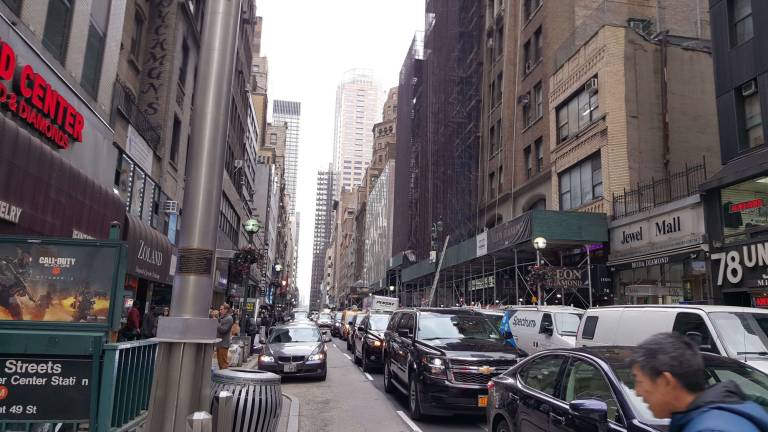How to Steal $12 Million in Diamonds: Not So Fast

For decades I’ve dodged a bullet; jury duty. I’ve been rejected because of relatives in the legal business. Once I was rejected for confessing to being an avid reader. This time around, I was called to do my civic duty. In the scheme of things, when you think of the risky service of police officers, military personnel, and firefighters, offering for a few (paid) weeks on a case is a minor inconvenience. If not me, who? If not now, when?
This crime occurred close to home; the Diamond District. The two on trial were merchants who were alleged to be in cahoots with ten others who pleaded guilty of conspiracy to defraud victims out of $12 million worth of diamonds.
During the trial we received a crash course on the tools and identifiers for how diamonds are chosen, bought and sold. I learned about how to launder money, say a few million dirty dollars, at a casino. Another technique the conspirators used was to give friends cash in exchange for a check written from their businesses to the conspirator’s company business.
One portion of the conspiracy took place in Bombay’s Diamond Bourse. This is the world’s largest diamond exchange with a total of three million square feet of office and storage space, and about 2500 large and small traders. Some 20,000 to 30,000 people visit daily.
The entire operation is based on trust; trust of the broker who brings you buyers, trust of the buyers based on the word of that broker, trust that a handshake called a mazal is as binding as a contract. A majority of the transactions are done with cash. If you need to launder money, you can pawn unmarked small diamonds, and you can deceive honest business owners with promises of big American dollars on credit. If you combine unmarked diamonds with cash and a handshake you’ve created a lure for the perfect crime.
Within this extremely loose environment there is one rule: a buyer company can only purchase $200,000 worth of product. This helps protect sellers and the insurers. To maximize their take these criminals created numerous fake, or shell companies, to increase the number of diamonds they could “purchase” (steal) from the sellers. The mastermind created a system, brought in a team, which included business cards, burner phones, and fake invoices to convince sellers they’d already had done business in the Bourse, and had paid on time.
One piece of evidence was a Diamond District map dotted with fake addresses garnered from the phony business cards. There really was only one office. In that office were the burner phones with phone numbers from the fake business cards. When sellers called demanding payment, anyone in that office could pretend they represented a company the seller was looking for.
When the company reps went to India, they went in pairs; one fake owner and one real appraiser. All these pairs worked with one Indian broker and his wife, whom the sellers in the Bourse knew. This couple was willing to dupe the sellers, lending their credibility to the big spenders from New York.
At first the shell companies paid cash, up front, for the diamonds. These diamonds were shipped from India to New York City. This established trust. Afterward, when the crooks returned to the Bourse, they asked for terms; 30 day, 60 day and 90 day terms. Numerous sellers, numerous companies, and many months went by, with payments coming due, and not paid for. When the Indian sellers tried to contact the New York City buyers on the cellphone numbers on the shell corporation business cards, they got vague answers, and no payments.
The government revealed, exhibit by exhibit, an autopsy of a crime. Submitted into evidence were endless invoices, signed receipts of accepted diamonds never paid for, hotel receipts, videos, fake business cards and photos of many of the conspirators dining together. Numerous vendors who were victims of the crime flew in from India to testify.
One of the final witnesses was a seller who had figured out that all the companies who’d bought from him were in cahoots. He came to America, bravely wore a “wire” (actually a high-tech FBI recording device in his pocket — it’s not 1969), and tried to convince the two defendants to go to the FBI to confess. Once a month for three months he flew over and met with the defendants, asking them to come clean to the FBI. Three times they refused. It was this testimony that showed the defendants were aware that a crime was being committed.
There are two snapshots I remember from this case. One is a chart showing the amount of money invoiced, the money paid, and the money owed by the shell companies over a period of time. On the chart’s left side the bars are small and somewhat even, with diamonds being delivered, and invoices paid. As the months pass you see an enormous amount of diamonds being “purchased,” delivered, and invoices left outstanding. At the very end of the chart the money owed to the victims is both stunning and sad.
While we all dread that jury duty notice, helping keep criminals in check is not only the responsibility of the police and the FBI. It’s our responsibility as citizens — and every four years isn’t so bad.